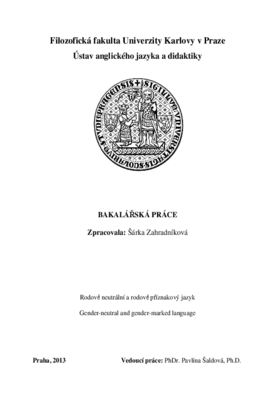Gender-neutral and gender-marked language
Rodově neutrální a rodově příznakový jazyk
bakalářská práce (OBHÁJENO)

Zobrazit/
Trvalý odkaz
http://hdl.handle.net/20.500.11956/57294Identifikátory
SIS: 133111
Kolekce
- Kvalifikační práce [22841]
Autor
Vedoucí práce
Oponent práce
Tichý, Ondřej
Fakulta / součást
Filozofická fakulta
Obor
Anglistika - amerikanistika
Katedra / ústav / klinika
Ústav anglického jazyka a didaktiky
Datum obhajoby
5. 2. 2013
Nakladatel
Univerzita Karlova, Filozofická fakultaJazyk
Angličtina
Známka
Velmi dobře
Klíčová slova (česky)
rod, sexismus, rodově příznakový jazyk, premodifikace, kolokabilitaKlíčová slova (anglicky)
gender, sexism, gender-marked language, premodification, collocabilityBakalářská práce se zabývá problematikou rodově neutrálního vyjadřování v angličtině (tzv. gender-neutral language). V úvodní části je podán přehled o vzniku a vývoji této otázky, která je příčinou celé řady jazykových změn v oblasti lexika a gramatiky. Terčem dlouhodobé kritiky je přirozená inklinace anglického jazyka k bezpříznakovému užívání mužského rodu, což se projevuje především v oblasti tradičních profesí, přísloví či ustálených spojení. Teoretická část se dále zaměřuje na klasifikaci a detailní popis gramatických a lexikálních jazykových prostředků vyjadřující rod a vysvětluje klíčové termíny. Empirická část je realizována na základě jazykového korpusu COCA, v němž byla zkoumána distribuce substantivních frází označující mužský a ženský rod (tzv. dual gender nouns), s ohledem na výskyt specifických rodově příznakových premodifikátorů. Cílem bylo zmapovat distribuci těchto jazykových prostředků u konkrétních substantiv a jejich kolokační tendence v současné americké angličtině.
The present thesis deals with the issue of gender-neutral language. The initial part centres around the origin and development of this issue, which has caused a series of language changes in lexis and grammar. An object of long-term criticism is the natural inclination of the English language towards the default use of the masculine gender, which is reflected especially in areas such as traditional occupations, proverbs and collocations. The theoretical part also focuses on the classification and detailed description of grammatical and lexical means of expressing gender and explains the key terms. The practical part is carried out on the basis of the data from the corpus COCA, in which the distribution of premodifying gender markers with specific dual gender nouns was examined. The project primarily maps these linguistic means in contemporary American English.
